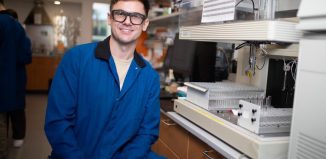CSH’s Raffaella Sordella seeks cancer drugs
Finding out why cancer cells become drug resistant should help patients recover
Back when she was in Boston, Raffaella Sordella was a part of an incredible discovery. Some patients with non-small cell lung cancer had mutations that made their tumors sensitive to drugs such as Tarceva and Iressa.
When the patients took the medicine twice a day, “the tumor was shrinking,” recalled Sordella. “Within a couple of weeks, the patient could resume a normal life, more or less.”
To top it off, the drug didn’t have all the side effects of conventional chemotherapy.
“This was a turning point in my career,” explained Sordella, who is originally from Turin, Italy, and was conducting her research at Massachusetts General Hospital.
The promising therapy for these patients, however, wasn’t as effective as researchers, clinicians and patients had hoped. Within a year, the tumors in even these patients had developed a resistance to the drugs.
Undeterred, Sordella decided she would search for reasons for the change. Now an associate professor at Cold Spring Harbor, Sordella is pursuing several possible explanations which she hopes one day will extend the effectiveness of drugs.
Lung cancer is the leading cause of cancer deaths in the world. It was responsible for 160,340 deaths in the United States in 2012, according to the American Cancer Society. More than 226,000 cases were diagnosed last year.
Tarceva and Iressa were sometimes effective initially on the tumors that harbor specific mutations because they blocked the epidermal growth factor receptors (or EGFR). Without signals from the EGFR sites, the tumors either stopped growing or began shrinking.
As Sordella and others have observed, however, these drugs became less effective over time. One possible explanation was that the cancers were changing, developing a secondary mutation that altered the way the tumor grew or developed. That likely accounted for about half of the cases. In the rest, scientists now know that resistance can develop through other mechanisms, such as the expression of other genes.
“If we understand the mechanism, we can slow down the process,” she explained. Scientists may not find a cure in the short term, but they may be able to extend the period when the tumors are sensitive to the drug out from one year.
Sordella discovered that the interleukin-6 protein, which was produced during inflammation, was responsible for decreasing the sensitivity of the tumor to the drugs.
Resistance was increased “by factors secreted during inflammation,” Sordella observed.
By turning off or blocking interleukin-6, researchers may be able to create a combination of drugs that blocks the growth and spread of tumors.
This, Sordella offered, would be considerably easier than trying to anticipate and stop the next cancerous mutation.
When she first started exploring the ways tumors might develop drug resistance, the most obvious, and medically most challenging possibility was that the tumor was heterogeneous, which means that it had a mix of cells with different genetic codes that kept it several steps ahead of the available drugs.
Sordella feels a scientific urgency to continue with her research, in the hopes of helping those suffering with cancer.
“What we are doing is not just for us,” she said. “It can make a difference to patients.”
Sordella and her husband Manuel Barriola, a theoretical physicist who works as a consultant, live on campus at Cold Spring Harbor. They have two daughters, Victoria, who is in second grade and Alicia, who is in kindergarten.
Sordella and her husband, who is from Spain, miss their connection to Europe. She explained that the Italian culture she grew up with is considerably different from that for third-generation Italian Americans.
“When I was in Boston, there was this old guy that learned I was Italian,” she recalled. “He spoke to me in what he thought was Italian.” Sordella suspected that he was speaking a dialect from Sicily and wasn’t able to understand a single word.
Sordella enjoys going to Manhattan to people watch. She said she doesn’t think about her research when she’s in the city, even though she knows cancer is so prevalent that any medical breakthrough could make a difference for everyone.
African violets
Continued from page B16
Any number of small insect pests, including aphids and spider mites as well as mealybugs, can attack African violets. I find that the yellow sticky traps are very helpful in dealing with insect pests in the house in general. If that doesn’t work, you may have to resort to using a pesticide. Make sure that the one you select can be used on houseplants and that you follow directions carefully.
Prevention is the best route to take. Check any new acquisitions carefully before bringing them into the house. You may also want to quarantine them for a few weeks so that if there is a problem it won’t affect your entire houseplant collection.
For more information, the African Violet Society of America can be reached at www.avsa.org.
Ellen Barcel is a freelance writer and master gardener. To reach Cornell Cooperative Extension and its Master Gardener Program, call 727-7850.






